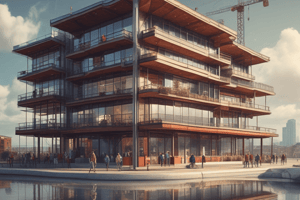Podcast
Questions and Answers
A Special Purpose property has unlimited utility and marketability.
A Special Purpose property has unlimited utility and marketability.
False (B)
All properties in the Special Purpose category are built-to-suit buildings.
All properties in the Special Purpose category are built-to-suit buildings.
True (A)
A hazardous waste facility is an example of a Special Purpose property.
A hazardous waste facility is an example of a Special Purpose property.
True (A)
Greenspace or campus areas are not typical amenities found in Special Purpose properties.
Greenspace or campus areas are not typical amenities found in Special Purpose properties.
Special Purpose properties are typically located in urban areas.
Special Purpose properties are typically located in urban areas.
The layout of a Special Purpose property is not specific to the type of industry or use.
The layout of a Special Purpose property is not specific to the type of industry or use.
Company headquarters are an example of a Special Purpose property.
Company headquarters are an example of a Special Purpose property.
A Special Purpose property can be easily repurposed for another use.
A Special Purpose property can be easily repurposed for another use.
Ivanhoe Cambridge - 3 Bryant Park is an example of a Special Purpose property.
Ivanhoe Cambridge - 3 Bryant Park is an example of a Special Purpose property.
All buildings designed for a specific purpose are Special Purpose properties.
All buildings designed for a specific purpose are Special Purpose properties.
Flashcards are hidden until you start studying
Study Notes
Office
- Office properties are classified into three categories: Class A, Class B, and Class C based on factors like location, size, design, and tenant types.
- Class A: High-quality, modern buildings with premium amenities and locations.
- Class B: Good quality but generally older buildings with fewer amenities and less prime locations.
- Class C: Older or less desirable buildings with fewer amenities and in less prime locations.
Retail
- Retail property is commercial real estate zoned and used for selling consumer goods and services.
- Retail space ranges from single-tenant buildings to neighborhood shopping centers to large shopping malls.
- Tend to have less than 15% office space, with occupants having flexibility in the use of the space.
- Sometimes referred to as flex/tech space, these buildings are an office-industrial hybrid that can have 30% to even 100% office finish.
Industrial
- Demand for industrial assets is heavily dependent on the overall strength of the economy and growth.
- Warehouse space in particular is also affected by export and import activity.
Multi-Family/Residential
- Multi-family properties are defined by properties specifically designed and built to accommodate living spaces for tenants.
- Characteristics include amenities and building features, layout, security, and management.
- Class A: Newer build, more luxurious amenities, modern, premium location, high-quality, and accessibility.
- Class B: Older building, good quality, medium to average conditions, and rent, fewer amenities, lacks premium finishes.
- Class C: Dilapidated building, inconsistent occupancy, little to no amenities, poor management, poor location, and cheap rent.
Special Purpose ("Other")
- A property that has limited utility/marketability other than for its original use, or is built-to-suit.
- A building designed for one specific purpose, such as a hazardous waste facility, specialized manufacturer, or company HQ.
- Characteristics include building amenities, layout, and location.
Studying That Suits You
Use AI to generate personalized quizzes and flashcards to suit your learning preferences.





